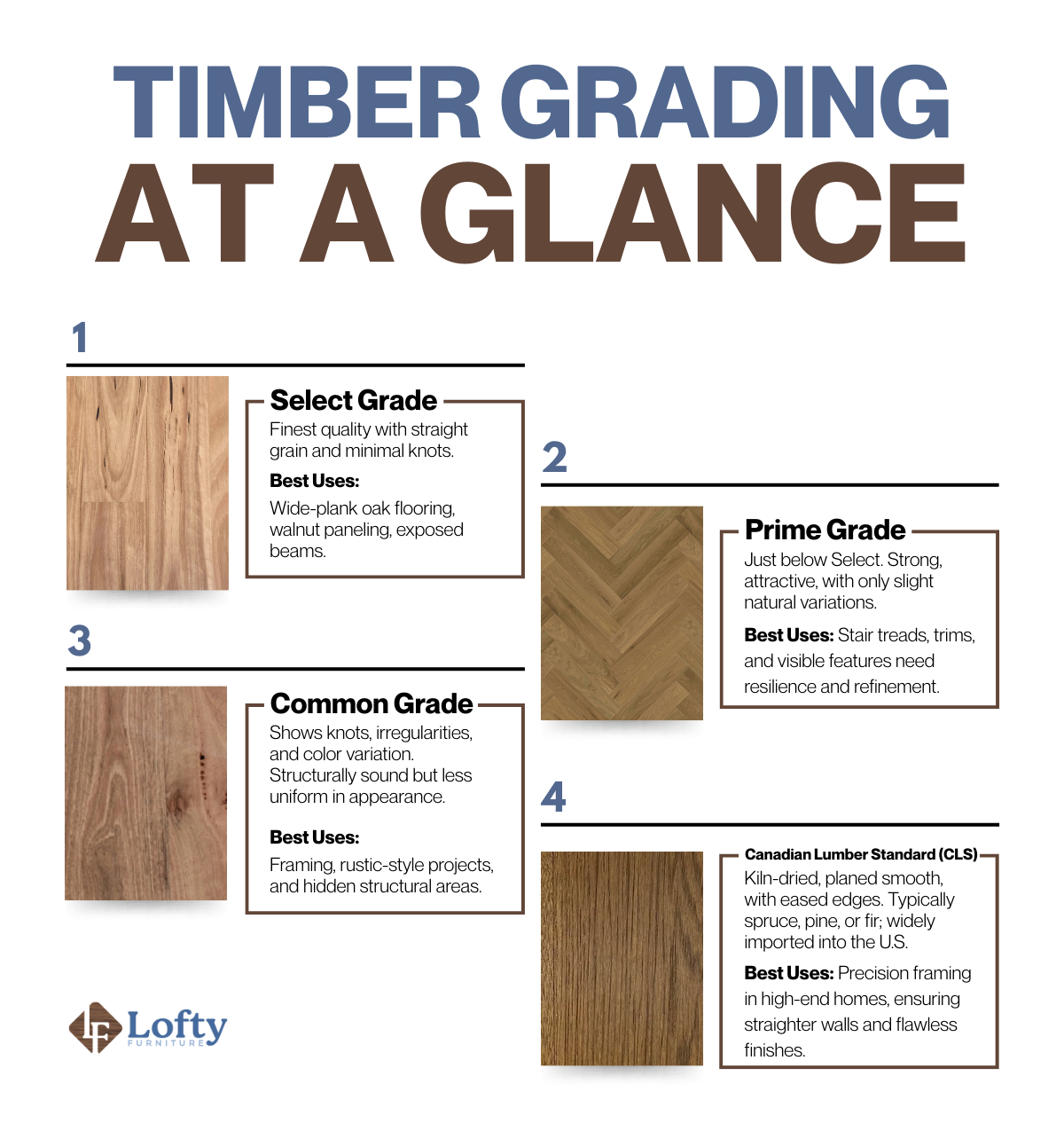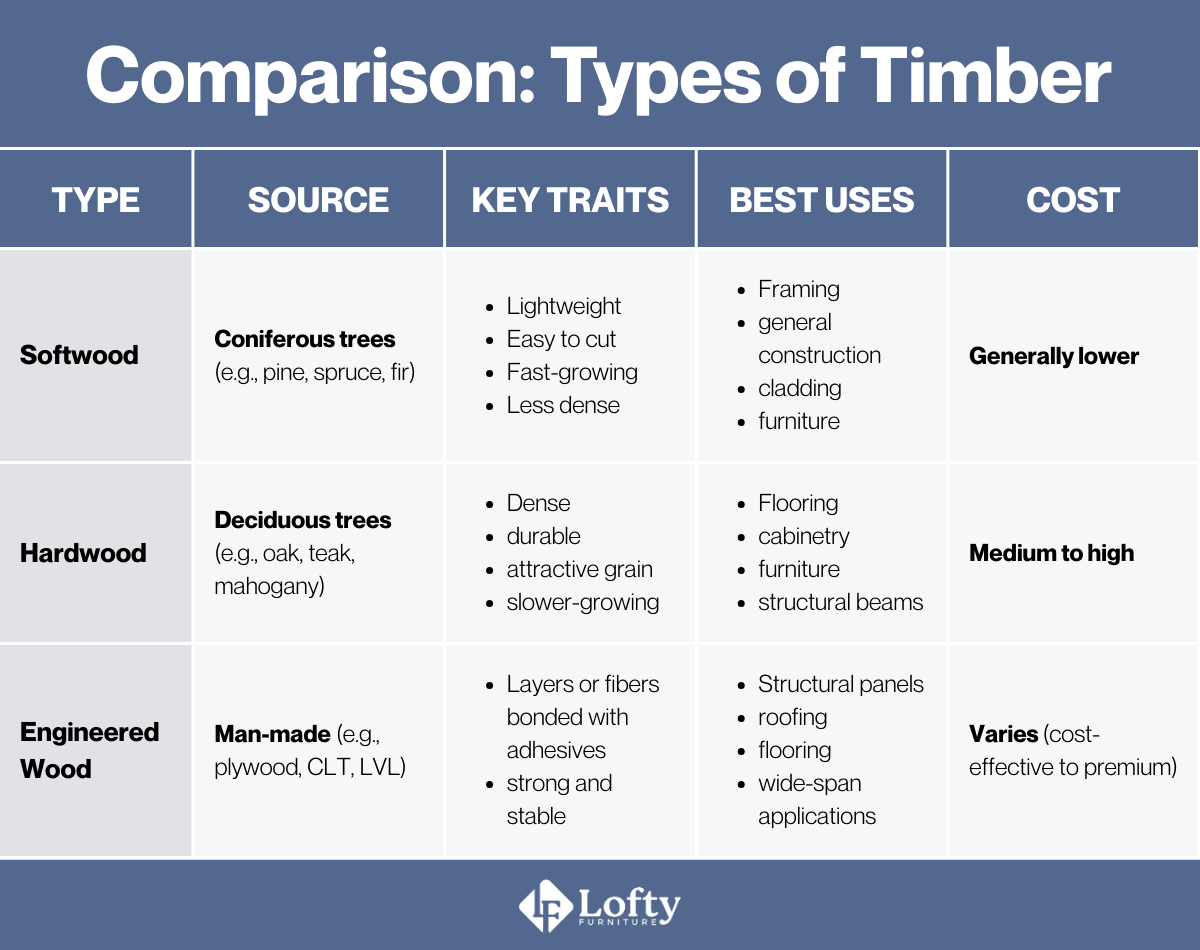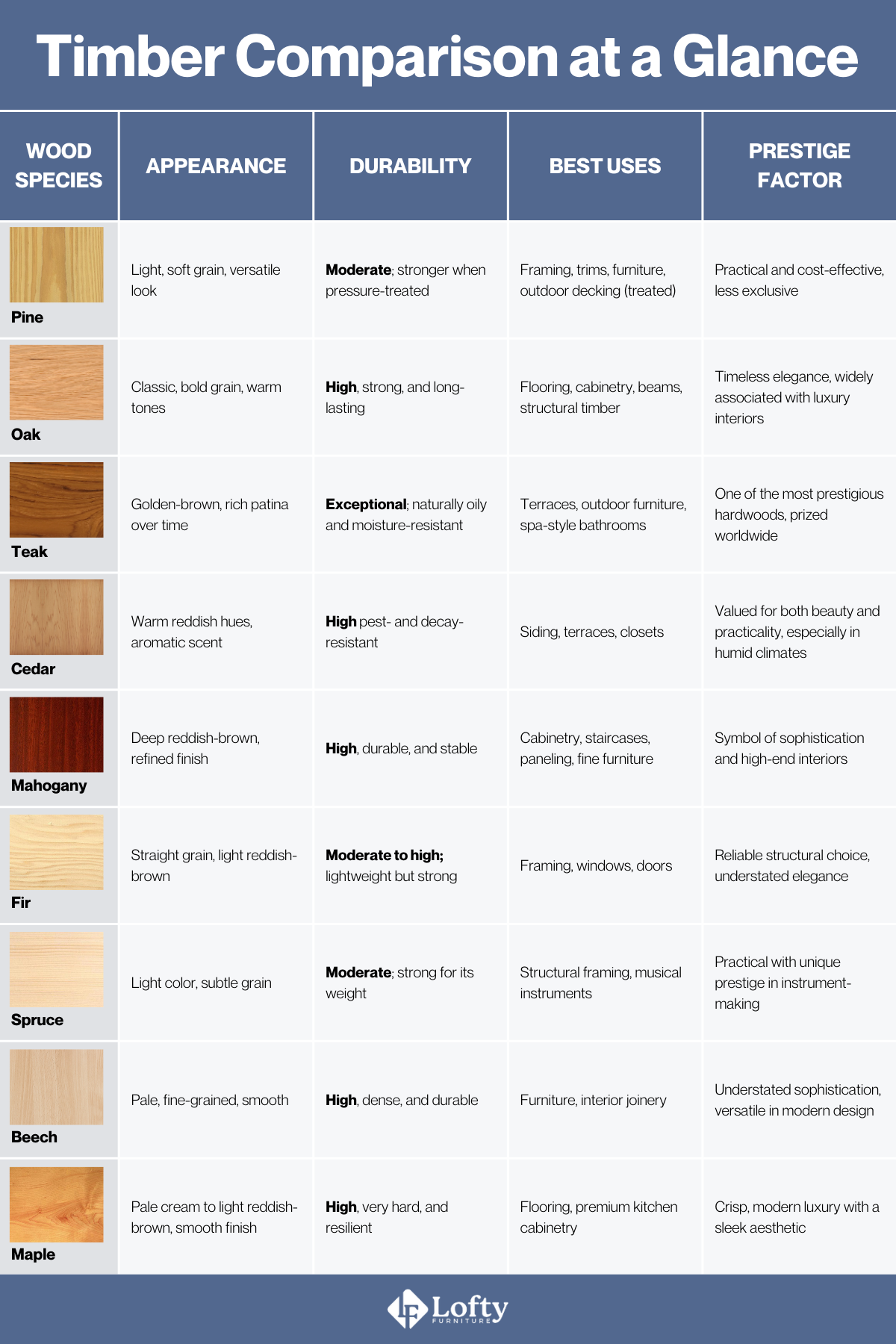When it comes to building something that stands the test of time, the materials you choose are crucial, especially when it comes to timber. Whether you’re constructing a home, a deck, or even a large commercial project, understanding the different types of timber available and how to use them is key to ensuring your structure is both durable and visually appealing. With so many options on the market, how do you know which timber is best for your project?
Key Takeaways:
- Different types of timber are suited for specific uses based on their strength, appearance, and durability.
- Timber grading helps you choose the right quality for either visible finishes or structural support.
- Proper care and sustainable choices help timber last longer and add value to your home.
In this guide, we will break down the most popular types of timber used in construction, highlight their unique characteristics, and explain where each one truly shines.
Understanding Timber Grades and Quality
Lumber and timber are often used interchangeably, but they’re not quite the same thing. Timber refers to wood that’s been prepared for construction, typically in the form of beams, planks, or panels. Lumber, on the other hand, is the finished product, or the boards you receive on-site or use to craft items like flooring. Before timber becomes the floor beneath your feet or the beam above your head, experts assess its quality to make sure it’s up to the task.
Grading systems set the standards for a board’s strength, stability, and appearance. For you, that translates into how elegant your floors look, how solid your beams feel, and how well your cabinetry holds up. Understanding these grades helps explain why some pieces stand out for their strength and beauty, while others quietly provide support behind the scenes.

When you’re building or renovating, choosing the right grade means both the visible and hidden elements of your property live up to the same standards of beauty and longevity. That attention to quality reflects the finest values in timber frame construction and modern timber production.
The Three Types of Timber
When it comes to choosing timber for construction, the variety of options can be overwhelming. Understanding the most common types can help you select the right one for your project, ensuring both durability and aesthetic appeal.
Timber generally falls into three main types: softwood, hardwood, and engineered wood.

1. Softwood
Softwoods come from coniferous trees like pine, fir, and spruce. They’re lightweight, easy to work with, and commonly used in framing, general construction, and trims.
Common Softwoods:
Pine – Affordable and versatile, used for framing, furniture, trims, decking, and fencing. Treated pine also works well outdoors.
Fir – Straight-grained and strong for its weight, ideal for timber framing, windows, and doors.
Spruce – Light yet strong, often used for structural framing and musical instruments.
Cedar – Lightweight, aromatic, and naturally pest-resistant; perfect for siding, terraces, closets, and humid environments.
2. Hardwood
Hardwoods come from deciduous trees like oak, teak, and mahogany. They’re denser, more durable, and often used for flooring, furniture, and premium wood finishes.
Common Hardwoods:
Oak – Strong with a striking grain; ideal for flooring, cabinetry, beams, and timber-frame structures. Boosts home resale value thanks to its classic appeal.
Teak – Naturally oily and moisture-resistant; great for outdoor furniture, terraces, and spa-style bathrooms.
Mahogany – Rich reddish tones, perfect for cabinetry, staircases, paneling, and fine furniture.
Beech – Dense and durable, suitable for furniture and interior joinery.
Maple – Hard, pale, and smooth; often used for premium flooring and kitchen cabinetry.
3. Engineered Wood
Engineered wood includes products like plywood, LVL (laminated veneer lumber), and cross-laminated timber (CLT). These are man-made for added strength, stability, and versatility, making them ideal for modern construction projects where durability and consistency are key.
Here’s how these timber species compare side by side, so you can see which fits your project and lifestyle best.

Discover the best wood options for your next desk and how each type affects style, durability, and craftsmanship. Learn more by exploring our detailed guide on types of wood desks.
How to Choose the Right Timber for Your Project
The right timber depends on where it’s being used and how much wear it needs to handle. Hardwoods like oak, teak, and maple are ideal for flooring, cabinetry, and visible features because they combine strength with natural beauty. Softwoods such as pine, fir, and spruce are better suited for framing, trim, or projects where cost and ease of use matter more than appearance.
For outdoor areas, naturally durable options like cedar and teak stand up well to moisture and pests, while pressure-treated pine offers a more affordable but effective solution. Engineered timber like cross-laminated timber (CLT) or laminated veneer lumber (LVL) works best for modern builds that need wide spans and structural consistency. Choosing certified sustainable or reclaimed wood adds environmental value and a sense of authenticity. Matching the timber’s qualities to its purpose ensures the final result is both practical and long-lasting.
Maintenance Tips for Long-Lasting Timber at Home
Timber will reward you if you care for it properly, and a well-maintained routine will ensure your investment remains beautiful for years to come.
Apply Finishes That Protect and Enhance
Premium finishes, such as natural oils, waxes, and lacquers, do more than protect timber. They enhance depth, highlight the grain, and impart a warm, inviting sheen to surfaces. In luxury interiors, many homeowners prefer hand-rubbed oils that create a silky finish while allowing the wood to breathe. High-gloss lacquers, on the other hand, lend a dramatic, polished effect ideal for statement cabinetry or staircases.
Control Climate and Environment
Timber reacts to its environment, so climate control is essential. Air conditioning, humidifiers, or dehumidifiers help prevent warping, cracking, or swelling. In homes with expansive windows or outdoor terraces, UV-resistant sealants keep sunlight from fading the rich tones of hardwoods like mahogany or teak.
Keep Up with Routine Care
Clean timber surfaces often with a soft, damp cloth and pH-balanced products to maintain their polished look and protect the finish. Use a vacuum with a soft brush attachment to remove dust and grit that could scratch the floors. For outdoor timber, such as decking, wash it seasonally and apply a new sealant to protect against moisture, salt, and changing weather conditions.
Refresh with Refinishing and Restoration
Even the best timber will eventually need renewal. Light sanding, re-oiling, or a fresh lacquer coat can restore its natural glow. For reclaimed timber, refinishing is especially valuable because it preserves character marks while stabilizing the wood for everyday use. Professional refinishing not only keeps your floors at their peak but also delivers a 147% return on investment, making it one of the smartest upgrades to protect both elegance and value (Realtor Magazine, 2022).
Treat Timber as a Long-Term Investment
Think of timber care as part of your home’s legacy. Whether you choose a teak terrace, a walnut-paneled library, or oak flooring underfoot, attentive maintenance keeps these features as striking tomorrow as the day you install them.

Conclusion: Finding the Right Types of Timber for Your Construction Project
Timber is more than a building material. It represents style, strength, and an investment in your home’s value. From engineered woods like CLT and LVL that enable bold designs to hardwoods like oak and teak that bring elegance to interiors, every choice you make shapes the future of your property. When you choose carefully, you ensure that every beam, plank, and panel reflects your vision of quality and beauty, creating a home that feels both timeless and uniquely yours.
Frequently Asked Questions
What do C16 and C24 mean in timber?
C16 and C24 are strength grades used for softwood construction timber, with C24 being stronger and more durable than C16. C24 is often used where higher loads or better appearance are needed, while C16 is suitable for general structural use.
What is the strongest type of timber?
Teak and oak are among the strongest and most durable hardwoods used in construction. For engineered strength, laminated veneer lumber (LVL) and cross-laminated timber (CLT) offer even greater consistency and load-bearing capacity.
Which timber is best for outdoor?
Teak and cedar are top choices for outdoor use due to their natural resistance to moisture, rot, and insects. Pressure-treated pine is also a popular and budget-friendly option for decking and fencing.
Is plywood a timber?
Plywood is a type of engineered wood made by gluing together thin layers (plies) of timber veneer. While it’s made from real wood, it’s not solid timber but is widely used in construction for its strength and stability.
